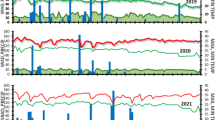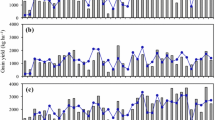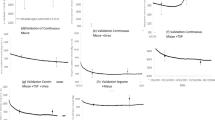Abstract
Maize has become the most important cereal in northern Ghana serving as cash crop and the main staple for most communities. It is the crop that receives most fertilizer input by farmers in the region, although the recommendations being used are over 20 years old. These recommendations were derived from relationships between crop yields and different applied rates of nutrient obtained from field fertilizer experiments. In most cases the experiments do not take care of the full extent of spatial and temporal variability associated with crop production. In addition the experiments are often very expensive and time consuming as they have to be carried out over many years in varied ecologies to be able to make valid recommendations for a region. Computer simulation model is a useful tool in this regard in reducing cost and time required for such studies, and also taking care of the spatial and temporal variability in the production of the crop. Response of maize to nitrogen in the northern Guinea savanna agro-ecology of Ghana was evaluated using the Seasonal Analysis component of the Decision Support System for Agrotechnoloy Transfer (DSSAT 4.02) – Cropping System Model (CSM). A simulation was performed for crop growth, development and yield of maize run for a site at Nyankpala near the University for Development Studies in the northern savanna agro-ecology. A field trial consisting of five nitrogen rates (0, 30, 60, 90, 120, kg/ha) with 30 kg K2O and 30 kg P2O5/ha was simulated for 24 years using measured daily weather and soil records for the site. The field trial was conducted under rain-fed conditions on a silty clay loam soil (Gleyi-ferric luvisol) in 2006. Quality protein maize (QPM) variety (Obatanpa) was the test crop. The economic analysis of the model took account of weather- and price-related risks, after carrying out a strategic analysis. The results showed that increasing levels of N up to 120 kg/ha increased maize grain yield at a diminishing return. The model accurately simulated maize grain yield up to 90 kg/ha nitrogen application but failed to accurately predict maize grain yield when nitrogen was applied at 120 kg/ha. Excessive water stress induced by high N application negatively affected the growth of maize. Nitrogen was leached most at N application rate of 120 kg/ha. Maize production was not profitable at N application rate ≤ 30 kg/ha on silty clay loam of the Guinea Savannah zone of Ghana. DSSAT-CSM can be used to accurately predict maize growth, development and yield in Ghana if well calibrated.
Access this chapter
Tax calculation will be finalised at checkout
Purchases are for personal use only
Similar content being viewed by others
References
Addiscott TM (1996) Fertilizers and nitrate leaching. Issues Environ Sci 5:1–26
Ahiabor DK, Fosu M, Tibo I, Sumaila I (2007) Comparative nitrogen fixation, native arbuscular mycorrhiza formation and biomass production potentials of some grain legume species in the field in the Guinea savanna zone of Ghana. W Afr J Appl Ecol 11:89–98
Bontkes TES, Wopereis MCS (eds) (2003) Decision support tools for smallholder agriculture in Sub-Saharan Africa: a practical guide. IFDC-CTA publication, Muscle Soals
Bontkes TES, Singh U, Chude VO (2001) Problems and opportunities in adopting system tools for decision-making related to soil fertility improvement in Africa. Paper presented at the INMR symposium, CIAT, Cali, Columbia, 2001
Boote KJ, Jones JW, Pickering NB (1996) Potential uses and limitations of crop models. Agron J 88:704–716
Boote KJ, Jones JW, Hoogenboom G, Pickering NB (1998) The CROPGRO model for grain legumes. In: Tsuji GY, Hoogenboom G, Thornton PK (eds) Understanding options for agricultural production. Kluwer Academic, Dordrecht
Bowen WT, Baethgen WE (1998) Simulation as a tool for improving nitrogen management. In: Tsuji GY et al (eds) Understanding options for agricultural production. Kluver Academic, Boston, pp 189–204
Chude VO, Amapu IY, Yusuf AA, Singh U, Breman H, Dejean P (2001) Validation of CERES-maize model under sub-humid tropical conditions. Nig J Soil Res 2:37–42
Fosu M, Kühne RF, Vlek PLG (2004) Improving maize yield in the Guinea Savanna zone of Ghana with leguminous cover crops and PK fertilization. J Agron 3:115–121
Fugger W-D (1999) Evaluation of potential indicators for soil quality in savanna soils in northern Ghana. (West Africa). PhD Thesis, Georg-August Universität, Göttingen, Germany
Hunt LA, Boote KJ (1998) Data for model operation, calibration, and evaluation. In: Tsuji GY et al (eds) Understanding options for agricultural production. Kluver Academic, Boston, pp 9–39
Jones JW, Tsuji GY, Hoogenboom G, Hunt LA, Thornton PK, Wilkens PW, Imamura DT, Bowen WT, Singh U (1998) Decision support system for agrotechnology transfer: DSSAT v3. In: Tsuji GY et al (eds) Understanding options for agricultural production. Kluver Academic, Boston, pp 157–177
Jones JW, Hoogenboon G, Porter CH, Boote KJ, Batchelor WD, Hunt LA, Wilkens PW, Singh U, Grijsman AJ, Ritchie JT (2003) The DSSAT cropping system model. Eur J Agron 18:235–265
Kasei CN (1988) The physical environment of semi-arid Ghana. In: Unger PW, SneedTV, Jordan WR, Jensen R (eds) Challenges in dryland agriculture : a global perspective, Proceedings of the international conference on dryland farming, 15–19 Aug 1988, Amarillo/Bushland. Texas Agricultural Experiment Station, Texas, pp 350–354
Landon JR (1991) A booker tropical soil manual: handbook for soil survey and agricultural land evaluation in the tropics and subtropics. Booker Tate, Thame, pp 58–125
Naab JB, Piara Singh K, Boote J, Jones JW, Marfo KO (2004) Using the CROPGRO-peanut model to quantify yield gaps of peanut in the Guinean Savanna Zone of Ghana. Agron J 96:1231–1242
Obeng HB, Erbynn KB, Asante EO (1990) Fertilizer requirements and use in Ghana. Report submitted to the Government of Ghana. Tropical Agricultural Development Consultancy. Accra Ghana, pp 197
Powlson DS (1997) Integrating agricultural nutrient management with environmental objectives – current state and future prospects. Proceedings No. 402. International Fertilizer Society, York, pp 1–44
Ritchie JT (1985) A user-oriented model of the soil water balance in wheat. In: Fry E, Atkin TK (eds) Wheat growth and modeling. NATO-ASI Ser. Plenum Publ. Corp, New York, pp 293–305
SRID (2007) Facts and figures. Statistics, Research and Information Department of Ministry of food and Agriculture, Ghana
Walker HO (1962) Weather and Climate. In: Wills J (ed) Agriculture and land-use in Ghana. Oxford University Press, London
Wilkens PW (2004) DSSAT v4. Weather data editing program, WeatherMan. DSSAT v4 user’s guide to cropping system models, vol 2. International Centre for soil fertility and agricultural development. University of Georgia, Griffin, Georgia, University of Florida, Gainsville
Author information
Authors and Affiliations
Corresponding author
Editor information
Editors and Affiliations
Rights and permissions
Copyright information
© 2012 Springer Science+Business Media B.V.
About this chapter
Cite this chapter
Fosu, M., Buah, S.S., Kanton, R.A.L., Agyare, W.A. (2012). Modeling Maize Response to Mineral Fertilizer on Silty Clay Loam in the Northern Savanna Zone of Ghana Using DSSAT Model. In: Kihara, J., Fatondji, D., Jones, J., Hoogenboom, G., Tabo, R., Bationo, A. (eds) Improving Soil Fertility Recommendations in Africa using the Decision Support System for Agrotechnology Transfer (DSSAT). Springer, Dordrecht. https://doi.org/10.1007/978-94-007-2960-5_10
Download citation
DOI: https://doi.org/10.1007/978-94-007-2960-5_10
Published:
Publisher Name: Springer, Dordrecht
Print ISBN: 978-94-007-2959-9
Online ISBN: 978-94-007-2960-5
eBook Packages: Biomedical and Life SciencesBiomedical and Life Sciences (R0)




